Assessment of Industry-Induced Urban Human Health Risks Related to Benzo[a]pyrene based on a Multimedia Fugacity Model: Case Study of Nanjing, China
Abstract
:1. Introduction
1.1. Review of Human Health Risk Assessment Studies
1.2. Study Area
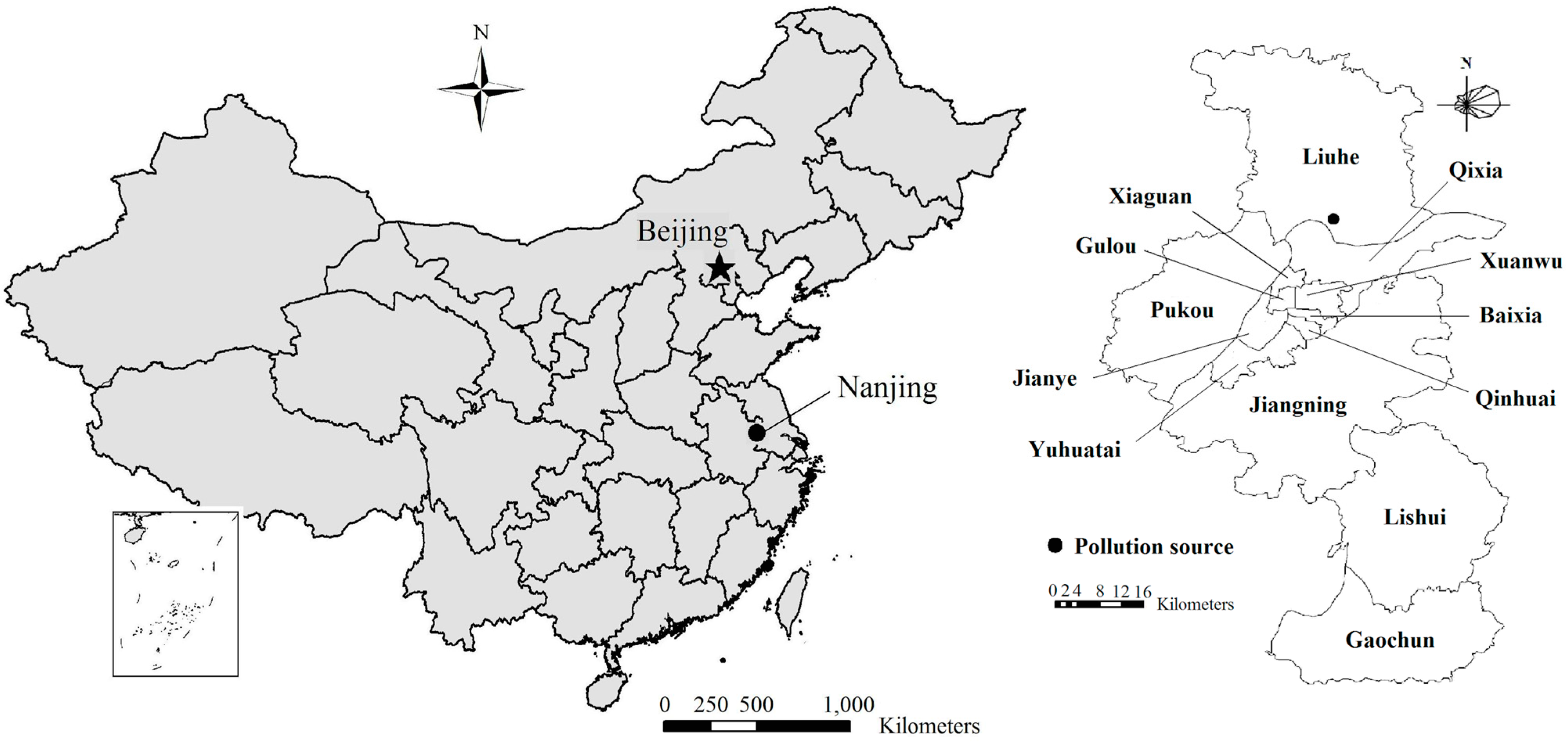
2. Materials and Methods
2.1. Spatial Data Extraction
2.2. Pollutant Concentration Calculation
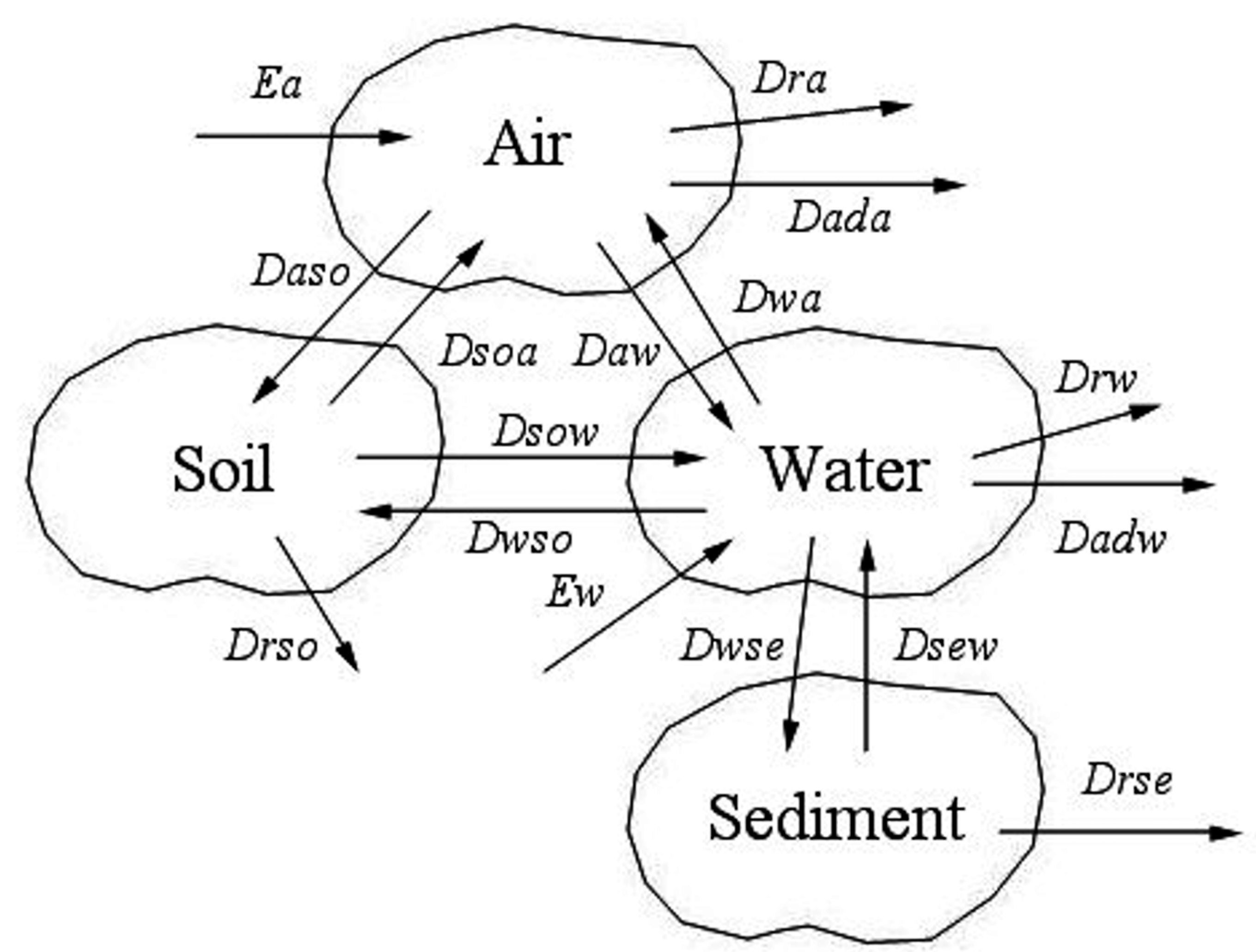
| Media | Source | 2002 | 2003 | 2004 | 2005 | 2006 | 2007 | 2008 |
|---|---|---|---|---|---|---|---|---|
| Air | Transportation a | 0.43 | 0.50 | 0.51 | 0.59 | 0.62 | 0.64 | 0.69 |
| Industry b | 0.89 | 1.04 | 1.06 | 1.22 | 1.28 | 1.32 | 1.43 | |
| Total | 1.32 | 1.54 | 1.58 | 1.82 | 1.90 | 1.96 | 2.12 | |
| Water | Industry b | 0.17 | 0.16 | 0.15 | 0.15 | 0.14 | 0.13 | 0.12 |
2.3. Health Risk Exposure Assessment
2.4. Health Risk Characterization
2.5. Uncertainty Analysis
3. Results and Discussion
3.1. Validation of the Multimedia Fugacity Model
| Compartment | Measured | Simulated | Unit | Literature | ||||
|---|---|---|---|---|---|---|---|---|
| Min | Mean | Max | Year | Mean | Year | |||
| Air | 0.962 | 5.1 | 31.6 | 2002–2003 | 2.34 | 2002 | ng/m3 | [20] |
| 0.41 | 4.17 | 19.4 | 2001–2002 | [28] | ||||
| Water | 0.015 | 0.024 | 0.033 | 2007 | 0.025 | 2007 | μg/L | [29] |
| 0.029 | 0.043 | 0.089 | 2007 | [30] | ||||
| Soil | ND a | 2.21 | 34.31 | Not specified | 16.00 | 2007 | ng/g(dry) | [31] |
| Sediment | 1.94 | 22.95 | 34.85 | Not specified | 15.04 | 2002 | ng/g(dry) | [32] |
3.2. Temporal Variations of Urban Human Health Risk Induced by Industrial Pollutant
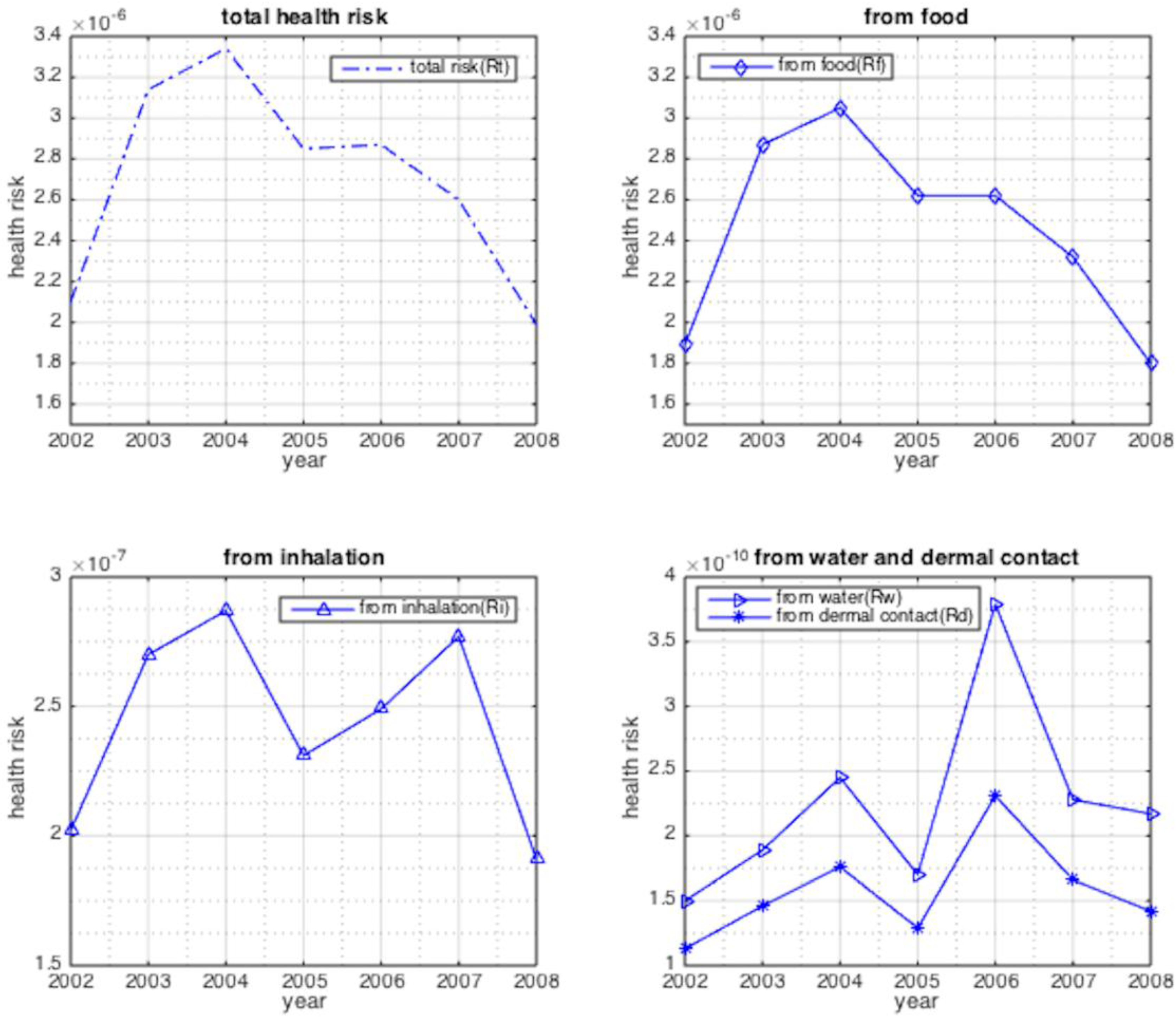
3.3. The Spatial Distribution of Urban Human Health Risk Induced by Industrial Pollutant
3.4. Uncertainty Analysis
3.4.1. Qualitative Analysis of the Model Uncertainty
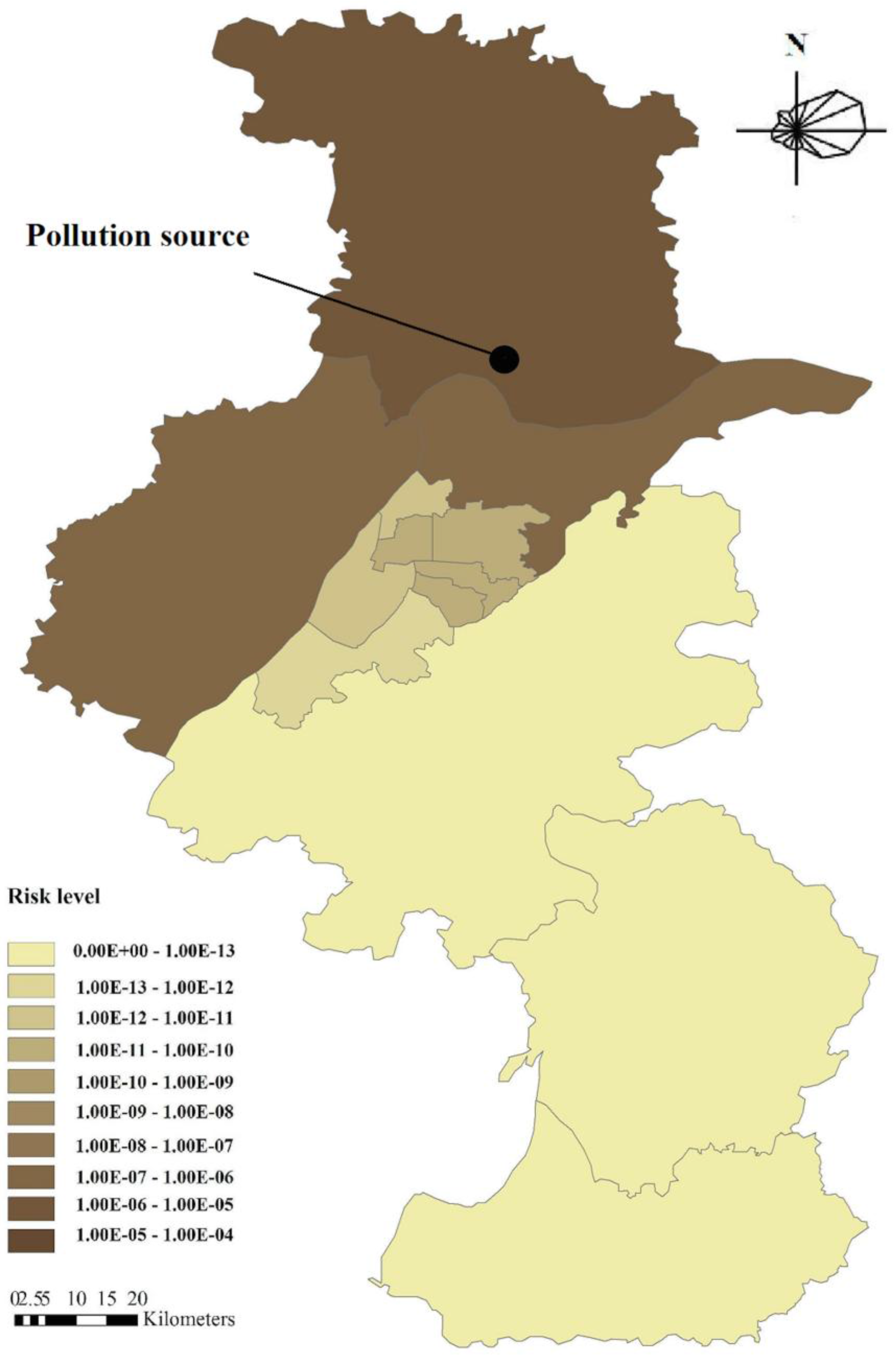
3.4.2. Sensitivity Analysis
| Factor | Ea | Ga | T | vaero | S | Kow | W | SFf |
|---|---|---|---|---|---|---|---|---|
| 1.1α a | 92.82% | −79.93% b | 84.66% | −77.35% | 87.24% | 87.24% | −83.80% | 91.96% |
| 0.9α | 93.25% | −96.26% | 85.09% | −94.11% | 85.09% | 85.52% | −102.28% | 92.39% |
| Group c | 1 | 1 | 1 | 1 | 1 | 1 | 2 | 3 |
3.4.3. Monte Carlo Simulation for the Parameter Uncertainty Analysis
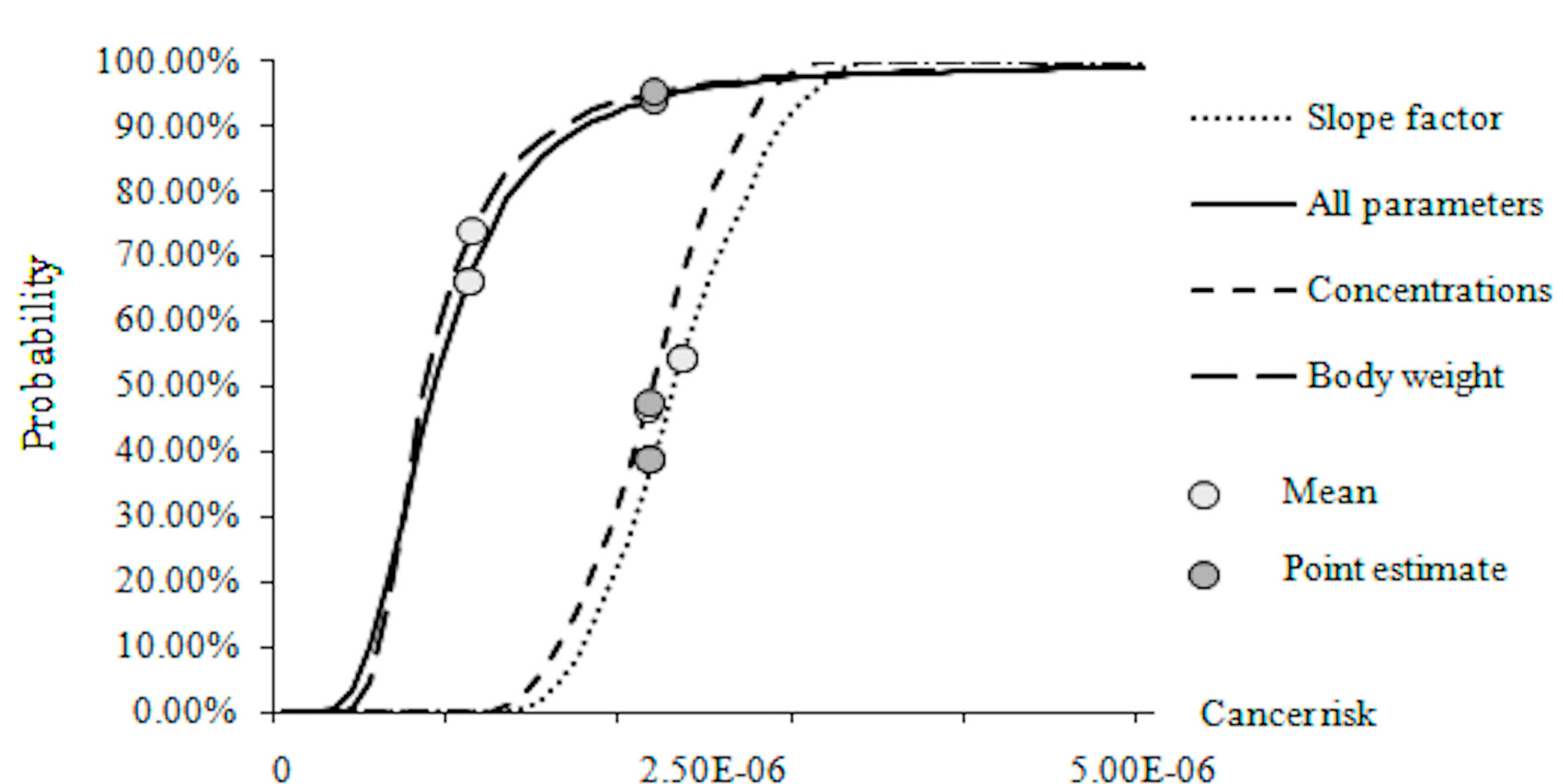
4. Conclusions
Supplementary Files
Supplementary File 1Acknowledgments
Author Contributions
Conflicts of Interest
References
- Higginson, J. Issues in industrialization, environment and health in developing countries. Toxicol. Ind. Health 1991, 7, 401–406. [Google Scholar] [CrossRef] [PubMed]
- Xu, L.Y.; Liu, G.Y. The study of a method of regional environmental risk assessment. J. Environ. Manag. 2009, 90, 3290–3296. [Google Scholar] [CrossRef] [PubMed]
- Xiong, S.C.; Chen, Y.J.; Zhi, G.R.; Sheng, G.Y.; Fu, J.M. Seasonal variation and carcinogenic assessment of particulate polycyclic aromatic hydrocarbons in Shanghai, China. Environ. Chem. 2009, 28, 117–120. (In Chinese) [Google Scholar]
- Lin, H.P.; Xie, M.Y.; Wu, X.Y.; Liu, Z.Q.; Wang, J.J.; Jiang, R.Y.; Gao, Z.L. Health risk assessment of PAHs air pollution in Xuanwei, China. J. Environ Health 2010, 27, 511–513. (In Chinese) [Google Scholar]
- Zhang, Y.Y.; Feng, L.; Liu, Z.T. Health risk assessment on semi-volatile organic compounds in Water of Yangtze Estuary Area. Res. Environ. Sci. 2007, 20, 141–145. (In Chinese) [Google Scholar]
- Dong, J.Y.; Wang, S.G.; Shang, K.Z. Water environmental health risk assessment of polycyclic aromatic hydrocarbons in the Lanzhou Reach of the Yellow River. J. Agr. Environ. Sci. 2009, 28, 1892–1897. (In Chinese) [Google Scholar]
- Li, X.R.; Zhao, T.K.; Yu, Y.X.; Zhang, C.J.; Li, P.; Li, S.J. Population exposure to PAHs and the health risk assessment in Beijing area. J. Agr. Environ. Sci. 2009, 28, 1758–1765. (In Chinese) [Google Scholar]
- Shi, X.X.; Wu, Y.; Zhang, H. Evaluation and simulation for ecological risk of urban expansion based on SERA model—Taking Selangor, Malaysia as an example. In Proceedings of 1st International Conference on Sustainable Construction & Risk Management, Chongqing, China, 12–14 June 2010.
- Sun, Y.B.; Zhou, Q.X.; Xie, X.K.; Liu, R. Spatial, sources and risk assessment of heavy metal contamination of urban soils in typical regions of Shenyang, China. J. Hazard. Mat. 2010, 174, 455–462. [Google Scholar] [CrossRef] [PubMed]
- Connell, D.W.; Wu, R.S.S.; Richardson, B.J.; Leung, K.; Lam, P.S.K.; Connell, P.A. Fate and risk evaluation of persistent organic contaminants and related compounds in Victoria Harbour, Hong Kong. Chemosphere 1998, 36, 2019–2030. [Google Scholar] [CrossRef]
- Ares, J. Estimating pesticide environmental risk scores with land use data and fugacity equilibrium models in Misiones, Argentina. Agr. Ecosyst. Environ. 2004, 103, 45–58. [Google Scholar] [CrossRef]
- Yang, Y.; Tao, S.; Wong, P.K.; Hu, J.Y.; Guo, M.; Cao, H.Y.; Coveney, R.M.; Zuo, Q.; Li, B.G.; Liu, W.X.; et al. Human exposure and health risk of α-, β-, γ- and δ-hexachlorocyclohexane (HCHs) in Tianjin, China. Chemosphere 2005, 60, 753–761. [Google Scholar] [CrossRef] [PubMed]
- Duan, Y.P.; Meng, X.Z.; Wen, Z.H.; Ke, R.H.; Chen, L. Multi-phase partitioning, ecological risk and fate of acidic pharmaceuticals in a wastewater receiving river: The role of colloids. Sci. Total Environ. 2013, 447, 267–273. [Google Scholar] [CrossRef] [PubMed]
- Mackay, D. Finding fugacity feasible. Environ. Sci. Technol. 1979, 13, 1218–1223. [Google Scholar] [CrossRef]
- Mackay, D. Multimedia Environmental Models: The Fugacity Approach, 2nd ed.; Lewis: Boca Raton, FL, USA, 2001. [Google Scholar]
- Wu, B.; Zhang, Y.; Zhang, X.X.; Cheng, S.P. Health risk from exposure of organic pollutants through drinking water consumption in Nanjing, China. Bull. Environ. Contam. Toxicol. 2010, 84, 46–50. [Google Scholar] [CrossRef] [PubMed]
- Macleod, M.; Mackay, D. An assessment of the environmental fate and exposure of benzene and the chlorobenzenes in Canada. Chemosphere 1999, 38, 1777–1796. [Google Scholar] [CrossRef]
- Nanjing Statistics Bureau. Nanjing Statistical Yearbook 2011; Nanjing Press: Nanjing, China, 2011. (In Chinese) [Google Scholar]
- Nanjing Statistics Bureau. Master Plan of Nanjing Chemical Industry Park; Nanjing Press: Nanjing, China, 2001. (In Chinese) [Google Scholar]
- Ding, S.J. Study on the Monitoring of Typical SVOCs in the Ambient Air of Nanjing City. Master Thesis, Nanjing University of Science and Technology, Nanjing, China, 2003. [Google Scholar]
- McLachlan, M.S. Bioaccumulation of hydrophobic chemicals in agricultural food chains. Environ. Sci. Technol. 1996, 30, 252–259. [Google Scholar] [CrossRef]
- Nifon, N.; Cousins, I.T.; Broman, D. Biomagnifications of organic pollutants in benthic and pelagic marine food chains from the Baltic Sea. Sci. Total Environ. 2008, 397, 190–204. [Google Scholar] [CrossRef] [PubMed]
- Takeuchi, I.; Miyoshi, N.; Mizukawa, K.; Takada, H.; Ikemoto, T.; Omori, K.; Tsuchiya, K. Biomagnifications profiles of polycyclic aromatic hydrocarbons, alkyl phenols and polychlorinated biphenyls in Tokyo Bay elucidated by delta C-13 and delta N-15 isotope ratios as guides to trophic web structure. Mar. Pollut. Bull. 2009, 58, 663–671. [Google Scholar] [CrossRef] [PubMed]
- Borak, J.; Sirianni, G. Hormesis: Implications for cancer risk assessment. Dose-Response. 2005, 3, 1559–3258. [Google Scholar] [CrossRef] [PubMed]
- Calabrese, E.J.; Baldwin, L.A. Can the concept of hormesis be generalized to carcinogenesis? Regul. Toxicol. Pharm. 1998, 28, 230–241. [Google Scholar] [CrossRef] [PubMed]
- Hose, J.E.; Puffer, H.W. Oxygen consumption rates of grunion (Leuresthestenuis) embryos exposed to the petroleum hydrocarbon, benzo[a]pyrene. Environ. Res. 1984, 35, 413–420. [Google Scholar] [CrossRef]
- USEPA. Exposure Factors Handbook. Available online: http://cfpub.epa.gov/ncea/cfm/recordisplay.cfm?deid=12464 (accessed on 22 August 1997).
- Wang, G.H.; Huang, L.M.; Zhao, X.; Niu, H.Y.; Dai, Z.X. Aliphatic and polycyclic aromatic hydrocarbons of atmospheric aerosols in five locations of Nanjing urban area, China. Atmos. Res. 2006, 81, 54–66. [Google Scholar] [CrossRef]
- Zhang, Y.; Zhang, X.X.; Wu, B.; Zhao, D.Y.; Li, M.; Cui, Y.B.; Ford, T.; Cheng, S.P. Degradation of benzo[a]pyrene in Yangtze River source water with functional strains. Ecotoxicology 2009, 18, 742–747. [Google Scholar] [CrossRef] [PubMed]
- Wu, B.; Zhao, D.Y.; Zhang, Y.; Zhang, X.X.; Cheng, S.P. Multivariate statistical study of organic pollutants in Nanjing reach of Yangtze River. J. Hazard. Mater. 2009, 169, 1093–1098. [Google Scholar] [CrossRef] [PubMed]
- Yin, C.Q.; Jiang, X.; Yang, X.L.; Bian, Y.R.; Wang, F. Polycyclic aromatic hydrocarbons in soils in the vicinity of Nanjing, China. Chemosphere 2008, 73, 389–394. [Google Scholar] [CrossRef] [PubMed]
- Xu, S.F.; Jiang, X.; Wang, L.S.; Quan, X.; Martens, D. Polycyclic aromatic hydrocarbons (PAHs) pollutants in sediments of the Yangtze River and Liaohe River. Chin. Environ. Sci. 2000, 20, 128–131. (In Chinese) [Google Scholar]
- USEPA. Risk Characterization Handbook. Available online: http://www.epa.gov/risk/guidance.htm (accessed on 12 December 2000).
- Song, H.M.; Xu, L.Y. A method of urban ecological risk assessment: Combining the multimedia fugacity model and GIS. Stoch. Environ. Res. Risk Assess. 2011, 25, 713–719. [Google Scholar] [CrossRef]
- Frey, H.C.; Zhao, Y.C. Quantification of variability and uncertainty for air toxic emission inventories with censored emission factor data. Environ. Sci. Technol. 2004, 38, 6094–6100. [Google Scholar] [CrossRef] [PubMed]
- Wang, B.; Yu, G.; Yu, Y.J.; Huang, J.; Hu, H.Y.; Wang, L.S. Health risk assessment of organic pollutants in Jiangsu reach of the Huaihe River, China. Water Sci. Technol. 2009, 59, 907–916. [Google Scholar] [CrossRef] [PubMed]
© 2015 by the authors; licensee MDPI, Basel, Switzerland. This article is an open access article distributed under the terms and conditions of the Creative Commons Attribution license (http://creativecommons.org/licenses/by/4.0/).
Share and Cite
Xu, L.; Song, H.; Wang, Y.; Yin, H. Assessment of Industry-Induced Urban Human Health Risks Related to Benzo[a]pyrene based on a Multimedia Fugacity Model: Case Study of Nanjing, China. Int. J. Environ. Res. Public Health 2015, 12, 6162-6178. https://doi.org/10.3390/ijerph120606162
Xu L, Song H, Wang Y, Yin H. Assessment of Industry-Induced Urban Human Health Risks Related to Benzo[a]pyrene based on a Multimedia Fugacity Model: Case Study of Nanjing, China. International Journal of Environmental Research and Public Health. 2015; 12(6):6162-6178. https://doi.org/10.3390/ijerph120606162
Chicago/Turabian StyleXu, Linyu, Huimin Song, Yan Wang, and Hao Yin. 2015. "Assessment of Industry-Induced Urban Human Health Risks Related to Benzo[a]pyrene based on a Multimedia Fugacity Model: Case Study of Nanjing, China" International Journal of Environmental Research and Public Health 12, no. 6: 6162-6178. https://doi.org/10.3390/ijerph120606162
APA StyleXu, L., Song, H., Wang, Y., & Yin, H. (2015). Assessment of Industry-Induced Urban Human Health Risks Related to Benzo[a]pyrene based on a Multimedia Fugacity Model: Case Study of Nanjing, China. International Journal of Environmental Research and Public Health, 12(6), 6162-6178. https://doi.org/10.3390/ijerph120606162






